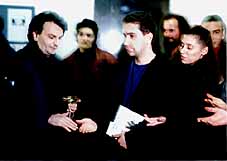 As
the most convincing and most authoritative protagonist of immaterial art
forms on the contemporary Yugoslav scene, but also as its outstanding
theoretician, Andrej Tisma calls his art works “(spi)rituals”
– rituals of the spiritual exchange, which means immaterial art intended
to be perceived neither though senses (like beaux arts), nor through a
mental process (like conceptual art). Instead, it was made for the human
spirit, which is a great potential waiting to be awakened, and the author
thus elicits at the same time the “material” he uses in his
work, the spiritual energy. He considers it a resourceful substance that
can be shaped, directed, spread, absorbed, etc, in order to reach an ultimate
goal, which is inspiration, the pure sensation of enlightenment and purification,
and the touch with the meaning of our existence, and that is the main
target of every artwork. The artist has almost been forced to give shape
to the “material” he has chosen by processes once used by shamans,
artists of the ancient times, that is, through ritual acts which function
directly, without any object serving as media, and in that way shorten
the communication channel to a great extent.
As
the most convincing and most authoritative protagonist of immaterial art
forms on the contemporary Yugoslav scene, but also as its outstanding
theoretician, Andrej Tisma calls his art works “(spi)rituals”
– rituals of the spiritual exchange, which means immaterial art intended
to be perceived neither though senses (like beaux arts), nor through a
mental process (like conceptual art). Instead, it was made for the human
spirit, which is a great potential waiting to be awakened, and the author
thus elicits at the same time the “material” he uses in his
work, the spiritual energy. He considers it a resourceful substance that
can be shaped, directed, spread, absorbed, etc, in order to reach an ultimate
goal, which is inspiration, the pure sensation of enlightenment and purification,
and the touch with the meaning of our existence, and that is the main
target of every artwork. The artist has almost been forced to give shape
to the “material” he has chosen by processes once used by shamans,
artists of the ancient times, that is, through ritual acts which function
directly, without any object serving as media, and in that way shorten
the communication channel to a great extent.
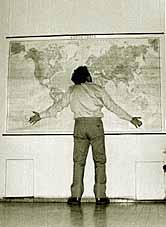 Following
the development of the author’s (spi)rituals through time, and having
in mind the above mentioned thoughts and observations, one inevitably
comes to certain conclusions concerning the seriousness and intellectuality
of the artist’s engagement in his work. But it is not a kind of engagement
which tends to criticize norms of behaviour and thinking. Its purpose
is to bring one to his own self in the noblest way. (Spi)rituals such
as “Love” (Belgrade, 1984) in which the author hugs and caresses
a map of the world hung on the wall, with words “I love you”
constantly repeating from a tape recorder (a line from Elvis Pressley’s
song “Love Me Tender”), “Inspiriting of Vransko Lake”
(Vransko Lake, 1990), where through inspiration, i. e. paying deep attention
to the lake, it becomes a work of art itself, then “Be Grateful Child
to Mother Earth” (Sremski Karlovci, 1990), where he puts some inspired
water from the lake on palms of hands of members of the audience, performing
thus a transmission of inspiration, “The Resurrection of the World”
(Milan, 1991), where he pours the inspired, consecrated water over some
soil brought from Yugoslavia, “Street Encounters” (Novi Sad,
1991) in which, during a nine-hours conversation with passers-by, he points
out that one should not go blindly down the streets, but pay more attention
to other people, or “A Student of Goodness” (Novi Sad, 1992)
in form of a lecture at the Philosophy Faculty during the students’
demonstrations, as well as “Landmark of Love” (Senta, 1993),
during which a stone was dug into the town park ground, a stone representing
the collective memory of the gathered group of people, left there to radiate
with love, and similar (spi)rituals can be explained with lines written
by Canadian poet Leonard Cohen: “LOVE IS A FIRE / IT BURNS EVERYONE
/ IT DISFIGURES EVERYONE / IT IS THE WORLD’S EXCUSE / FOR BEING UGLY”.
Following
the development of the author’s (spi)rituals through time, and having
in mind the above mentioned thoughts and observations, one inevitably
comes to certain conclusions concerning the seriousness and intellectuality
of the artist’s engagement in his work. But it is not a kind of engagement
which tends to criticize norms of behaviour and thinking. Its purpose
is to bring one to his own self in the noblest way. (Spi)rituals such
as “Love” (Belgrade, 1984) in which the author hugs and caresses
a map of the world hung on the wall, with words “I love you”
constantly repeating from a tape recorder (a line from Elvis Pressley’s
song “Love Me Tender”), “Inspiriting of Vransko Lake”
(Vransko Lake, 1990), where through inspiration, i. e. paying deep attention
to the lake, it becomes a work of art itself, then “Be Grateful Child
to Mother Earth” (Sremski Karlovci, 1990), where he puts some inspired
water from the lake on palms of hands of members of the audience, performing
thus a transmission of inspiration, “The Resurrection of the World”
(Milan, 1991), where he pours the inspired, consecrated water over some
soil brought from Yugoslavia, “Street Encounters” (Novi Sad,
1991) in which, during a nine-hours conversation with passers-by, he points
out that one should not go blindly down the streets, but pay more attention
to other people, or “A Student of Goodness” (Novi Sad, 1992)
in form of a lecture at the Philosophy Faculty during the students’
demonstrations, as well as “Landmark of Love” (Senta, 1993),
during which a stone was dug into the town park ground, a stone representing
the collective memory of the gathered group of people, left there to radiate
with love, and similar (spi)rituals can be explained with lines written
by Canadian poet Leonard Cohen: “LOVE IS A FIRE / IT BURNS EVERYONE
/ IT DISFIGURES EVERYONE / IT IS THE WORLD’S EXCUSE / FOR BEING UGLY”.
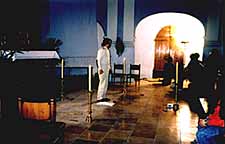 Andrej
Tisma, however, does not see the world as something ugly, and thinks it
is, in fact, worth fighting for. He does not do that by using the characteristic,
usual language of engaged art (like aggressiveness, shock and irony) –
although he is sometimes close to those elements as reaction to reality:
“You Can’t Buy Love, Faith, Friends and Art” (Amsterdam,
1990) is an action with a stamp with the title engraved on it, whose prints
he distributed at a symposium “Art Meets Science and Spirituality
in a Changing Economy” (The Stedelijk Museum), “Declaration
of Peace” (Sremski Karlovci, 1991), in which he breaks knives in
The Peace Chapel, “Air-Raid Alarm” (Novi Sad, 1992) in which
Tisma threw plastic military toy airplanes into a jar of water, “Love
from Cage” (Belgrade, 1993) – he spent some time in a metal
cage placed in one of the busiest streets of central Belgrade, or “The
New World Ordure” (Novi Sad, 1994), which is a parody of one personality
which symbolizes world power.
Andrej
Tisma, however, does not see the world as something ugly, and thinks it
is, in fact, worth fighting for. He does not do that by using the characteristic,
usual language of engaged art (like aggressiveness, shock and irony) –
although he is sometimes close to those elements as reaction to reality:
“You Can’t Buy Love, Faith, Friends and Art” (Amsterdam,
1990) is an action with a stamp with the title engraved on it, whose prints
he distributed at a symposium “Art Meets Science and Spirituality
in a Changing Economy” (The Stedelijk Museum), “Declaration
of Peace” (Sremski Karlovci, 1991), in which he breaks knives in
The Peace Chapel, “Air-Raid Alarm” (Novi Sad, 1992) in which
Tisma threw plastic military toy airplanes into a jar of water, “Love
from Cage” (Belgrade, 1993) – he spent some time in a metal
cage placed in one of the busiest streets of central Belgrade, or “The
New World Ordure” (Novi Sad, 1994), which is a parody of one personality
which symbolizes world power.
Trying to awaken in people a consciousness of belonging to humankind and everyone’s mutual dependence (“Love”), putting an accent on the right of individual freedom and equality of races (“Liberte, Fraternite, Egalite 1789-1989” and “Stigmatization”), on the relations between an individual on the one hand, and nature and social environment on the other (“Be Grateful Child to Mother Earth”, “43 Cubic Meters of Love”, or “Tisma at Delifrance”) or on relations of an individual to another individual (“Street Encounters” and “Spirit Control”) as well as on his personal attitude toward centers of power (“Encounter in my Heart”), this artist creates a spiritual space which unifies and crystallizes emotions which are rather general and common than personal, and, in relation to the society, they are not a reflection of the world outside, even to a lesser extent are they an expression of the artist’s own consciousness or feeling, but they are, in fact, first of all, catalysts of the collective consciousness.
Many (spi)rituals performed by Andrej Tisma have been documented in various ways. Most of them, the documents were made with a stamp designed by the author himself, or they were in forms of photocopies of documentary photograph collage, art postcard, silk-screen, but also made in a way typical of processual art. The following example illustrates the way, and it can be followed in the series of performed (spi)rituals, beginning with “The Inspiriting of Vransko Lake”. Before he went on holiday, Tisma noticed in a picture taken from a satellite (in a map atlas) that Vransko Lake looks like an eye gazing at the Universe, so he decided to transmit his inspiration to the lake in a direct contact with it. (“Instead of painting a landscape, I wanted to emit my own enthusiasm to it” – Tisma said.) In the same year, when he returned, he performed the (spi)ritual entitled “Be Grateful Child to Mother Earth”, in front of a wall with picture showing the transmission of inspiration to Vransko Lake projected on it, he distributed the inspirited water from the lake among the audience putting it on palms of everyone’s hand (“I want to transfer the inspiration I felt on the lake to you, not by a painting but by means of this water.”) Next year (1991) he uses water from Vransko Lake once again, during a (spi)ritual performed in Paris, during the Gulf Crisis. He pours the inspired water over a piece of soil brought from Iraq (a tile from the tower of Babylon), in order to clean it from layers of evil (an association of the act of Christening), saying his wish for peace. Later he used water from the lake as one of the props for “Resurrection of the World”, the above described (spi)ritual performed in Milan. After that, in a very impressive (spi)ritual entitled “Declaration of Peace” (a slide illustrating the “Resurrection of the World” was shown, and a stone from Illyric times, a prop from the (spi)ritual “Illyrians, Forgive Us”, which had previously been performed below the palace of Queen Teuta, was placed in the center of The Peace Chapel) he spilt the soil used in Milan around the audience and eventually took knives from candle stands placed in four major directions, broke them one by one and put candles in their places, with words: “I declare peace!”. Tisma explained his motives with the following: “In the place where the 1699 world peace treaty was signed, I intended to evoke the event strongly because of numerous similarities in today’s situation”.
By awakening spirituality in the field of his own existence in space and time, Andrej Tisma does not only confirm himself as an artist, but also brings to the surface or reality some categories of value buried deep inside every being, which have been - whether we are willing to admit it or not – suppressed through time.
|
Art As Telepathy And (Spi)ritual by Andrej Tisma, 1990
I call my activities (spi)rituals - rituals of spiritual exchange. This is non-material art which is intended neither for the senses (like the fine arts), nor for the intellect (like conceptual art). It is directed at the human spirit and its great potential, now more or less dormant which needs to be awakened. Just as a sculptor shapes clay, I want my art to make use of the human spirit, that inexhaustible substance which when handled intelligently can be shaped, guided, expanded and absorbed. The ultimate artistic work is inspiration itself, that pure feeling of enlightenment and cleansing. It touches the meaning of existence, which, after all, is what all art strives for, except that here the path is shorter and effects direct, since there is no object as intermediary. My latest (spi)rituals consist of attempts to transfer spirit to artistically uninteresting objects and materials (pieces of paper, water, rock etc.), which I then mail or distribute in some other way, and which are supposed to radiate my inspiration to the recipient. I also carry out actions in a natural setting, sending out my positive spirituality to the surrounding world. Spiritual exchange, inspiration, and telepathy are forms of a future non-material art which is now being seen in different parts of the world, and will be established in the next millennium.
November 22, 1990
Previously published in ND Magazine no 14, Austin, Texas, 1991
|
|
Building of the Tower of Angels
The Tower of Angels is a seat to all the good beings who are united in their actions leading to peace, prosperity, harmony, love and victory of good over evil. Every day my building grows stronger, more beautiful, ever richer and more effective. I have built into the Tower of Angels people’s smiles, glow from the eyes of those I had met, beauty of bodies and of landscapes I had admired. I had put into it all the love for my parents, my wife, my child and all their love for me, the love for animals and plants, for the lovely day, the Sun, the wide blue sky, clouds, tree crowns, flowers, water, food and drink. The Tower contains the love of all the people who had ever lived for nature, their neighbor, for their food and drink, the sky and the Sun. I have built into the Tower all my love for arts, for every artwork I have seen or created, love of all human beings for artworks; music, theatre, film, painting, literature. I have built into it my love and admiration for God, the love of all people who have ever lived for God in all religions, God’s love for all people and all the world. I have built into it God himself. I have built in it the love of all benefactors for men and women, for children and nature, and the love of all people for benefactors. I have built in it the love of Jesus Christ for all people and the love of all people for Christ. I have built into it Christ himself. I have built into the Tower of Angels all the love between men and women, all the pleasures arising from their love, all the joy and merriment coming from their love. I have included into the Tower the love of all mothers for their children, of all fathers for their children, and the love of all children for their parents. Love of all children for their neighbors, the neighbors’ love for children, and love among children. The love among friends, acquaintances and unfamiliar ones. The love of all people for animals and animals’ love for people, the love of all people for nature and nature’s love for people. All the love among animals and the love for their offspring, the love among plants, the love of the Earth and plants for the rain and the Sun, the love of the Sun for plants and the soil. I have built into the Tower the Sun itself. I have put into it all the joy of people, the joy of other creatures, all the beauty of the world and admiration of people for the beauty. I have also built in all the pleasures of all the creatures of this world and all the joy of all creatures in the entire universe. I have built into it the pleasure of people with the fruits of nature and their admiration for them. The joy because of the strength and health that nature and her fruits give us. The joy of life, the joy of seeing all the beauty around us, the joy of taking and the joy of giving. The joy of all people about the good news they have received, the joy about pleasant messages, ideas and thoughts. The joy of all the hungry ones when they were given food, the joy of the thirsty when they were given water, the joy of the sick when they were cured. The joy of those who found their lost ones, the joy of the lost when they were found. The joy of creative people that ever existed with the works they created, the joy of all people with works they have completed. I have put into it the love of all children for play, the love of adults for amusement, joke and relaxation. The joy and pleasure of enjoying one’s food, drink, pleasant walk or ride in a town or countryside. The pleasure of all creatures in moving, flying, swimming, their pleasure in taking a rest and sleeping. I have built into the Tower the joy of people when wars were over and peaceful life has being restored, the joy of the exiled when they returned home, the joy of all the homeless when they get a home. The joy of the lonely who have found friends, the joy of the separated when they met again. While building the Tower of Angels, my days were filled with great joy and exaltation. I hovered in a cloud of beauty, often surrounded by beautiful sights and pleasures, so it was easy to choose. Now, again, I feel the same pleasure and I wish to invite you to join me in the building of this spiritual edifice of positive energy, goodness, beauty and love. I am inviting you to contribute your ideas about what else could be built into the Tower of Angels, enabling an ever faster and more impressive growth of this ramparts against evil, that fortress of good in this world. Andrej Tisma Novi Sad, July 1, 1999 |
[Andrej
Tisma (Novi
Sad, Yugoslavia, 1952) graduated from Academy of Fine Arts in Prague,
Czechoslovakia in 1976. From the early '70s Tisma was concerned with concrete
poetry, mail-art, photography, xerox, and since '80s with performance
art and video. He has had solo exhibitions beginning in 1972 in Novi Sad,
Belgrade, New York, Milan, Seoul, Munich, Naples, and San Francisco. Since
1996 Tisma has been working in the field of digital graphics and web-art.
He has been publishing art criticism and essays since 1976. Tisma lives
in Novi Sad, Serbia working as an artist, art critic, and curator.]
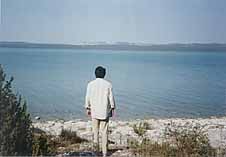 In
1984 I began with performances by which I hoped to directly affect
people's spirits. My performance entitled "Love", in 1984,
already constituted an attempt through telepathy and magic, to transmit
love to the entire world (aided by a map of the world). In New York
in 1987 I imprinted my rubber-stamp messages on people in the street,
hoping to leave my mental stamp on them. With a series of similar
performances (or interactions), in which I use conversation, lecture,
distribution of printed matter and imprinting stamps on viewers'
bodies, I strive to imbue them with inspiration and enlightenment.
In
1984 I began with performances by which I hoped to directly affect
people's spirits. My performance entitled "Love", in 1984,
already constituted an attempt through telepathy and magic, to transmit
love to the entire world (aided by a map of the world). In New York
in 1987 I imprinted my rubber-stamp messages on people in the street,
hoping to leave my mental stamp on them. With a series of similar
performances (or interactions), in which I use conversation, lecture,
distribution of printed matter and imprinting stamps on viewers'
bodies, I strive to imbue them with inspiration and enlightenment.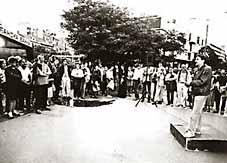 During
the three months of bombardment of my town and country in May 1999,
in a refuge far from home, I started realizing what is perhaps my
greatest work of art, as an answer to the war and destruction around
me - "The Tower of Angels". Below is the text I compiled
during months which I then read during a public performance in the
streets of Novi Sad on July 1, 1999 after the bombardment stopped.
During
the three months of bombardment of my town and country in May 1999,
in a refuge far from home, I started realizing what is perhaps my
greatest work of art, as an answer to the war and destruction around
me - "The Tower of Angels". Below is the text I compiled
during months which I then read during a public performance in the
streets of Novi Sad on July 1, 1999 after the bombardment stopped.